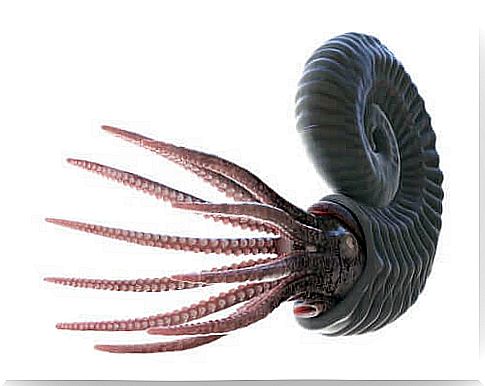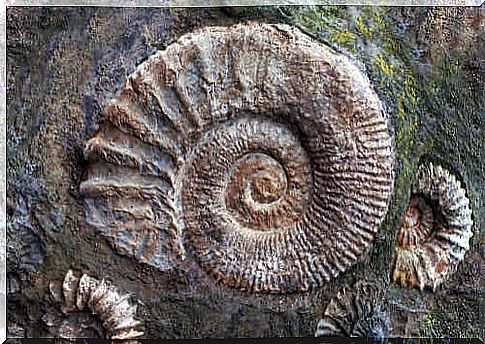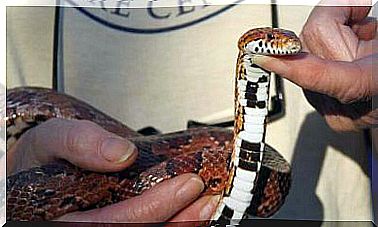The Fascinating World Of Amonoids

Amonoids are a type of prehistoric marine mollusc very successful from an evolutionary point of view, as they managed to inhabit our planet for over 300 million years. In the last 500 million years, the planet has gone through five episodes of mass extinction, and as a result, more than 90% of the organisms that once walked, swam, flew or crawled on Earth have disappeared from it.
Ammonites have survived in different geological eras.
Throughout the planet’s history, amonoids as a group have managed to survive several catastrophic extinction events, though often only a few representative species remain. However, each time, this group of species managed to diversify in several ways.
During the latter part of the Mesozoic era, amonoids became less abundant, but in the Cenozoic era none of them survived. Thus, the last lineages of amonoids disappeared along with the dinosaurs 65 million years ago, in the extinction event at the end of the Cretaceous period.
Ammonite fossils, useful to mark the geological calendar
Certainly, almost all of us have seen an ammonoid fossil, as they are so abundant across the planet. These fossils form as the animal’s remains are buried in sediments that later solidify, giving rise to rocks with the same shape.
Thus, by being trapped in different terrestrial strata throughout the planet’s history, amonoids have become useful indicators to mark periods of geological history. This use is possible because of two characteristics of the animal:
- Rapid evolution : because of this characteristic, species of amonoids had a relatively short duration. Thus, on the same geological scale, fossilized species in marine sedimentary rocks become characteristic.
- Global geographic distribution : Ammonoids are relatively common and reasonably easy to identify.
Thanks to these characteristics, amonoids can be used to distinguish geological time intervals of less than 200,000 years in duration. In terms of Earth’s history, this is very accurate.

The classification of amonoids
Extinct animals, as well as animals still alive, are classified into taxa, genera and species. Thus, amonoids are classified as cephalopods of the Ammonoidea subclass . To date, nine orders of amonoids are recognized: five from the Paleozoic era and four from the Mesozoic. We’re talking about 10,000 species of amonoids in total.
What is known about amonoid shells?
According to fossil records, amonoids have a spiral-shaped shell, whose most important functions were protection from predators and buoyancy. As the animal grew, it built new chambers in the shell, and each chamber was separated internally by a septum.
This architecture gave strength to the shell and prevented the animal from being crushed by the external pressure of the water. Despite this, according to estimates, it is believed that the amonoids could not support depths greater than 100 meters.
It is interesting to know that the animal lived only in the outer chamber of the shell. The inner chambers were filled with air or fluid that was regulated by the amonoids to control their buoyancy and movement, similar to what happens in a submarine.
Furthermore, these shells varied greatly in their surface: some were smooth and smooth, while others had spiral ridges, ribs or even spines. Although the spiral is the typical shape, some genera of amonoids had shells that curled up in quite strange ways. They are known as heteromorphs.
What were these creatures’ appearance and living habits?
Ammonites, like most other cephalopods, were predators. Thus, these creatures similar to the current nautilus, had horny beak-shaped structures inside a ring of tentacles. Their soft bodies extended from their shells to capture prey such as small fish and crustaceans.
It is also assumed that the amonoids moved through the warm, shallow seas, using both the buoyancy of their shell’s inner chambers and jet propulsion.

Was there a giant amonoid?
Throughout history, species of amonoids have undergone numerous changes. On the American continent, the largest amonoid documented was the species Parapuzosia bradyi, from the Cretaceous period, with specimens measuring 137 centimeters in diameter.
However, the size record belongs to the species Parapuzosia seppenradensis, also from the Cretaceous, with 1.95 meters in diameter. This specimen, found in Germany in 1895, is estimated to have a diameter of approximately 2.55 meters in life.
On the other hand, among the smaller amonoids, there are the nanocardioceras that lived in the late Jurassic. In this species, adult individuals are rarely more than two centimeters in diameter.
Final grade
The beautiful fossil shells of amonoids have been collected by people for millennia. Their appearance made them the protagonists of several myths: during medieval times, it was believed that they were serpents turned into stone and had commercial value, as they were sold to people on pilgrimages.
However, their use to date marine sediments with extreme precision has made them essential for generating geological knowledge about our planet.









